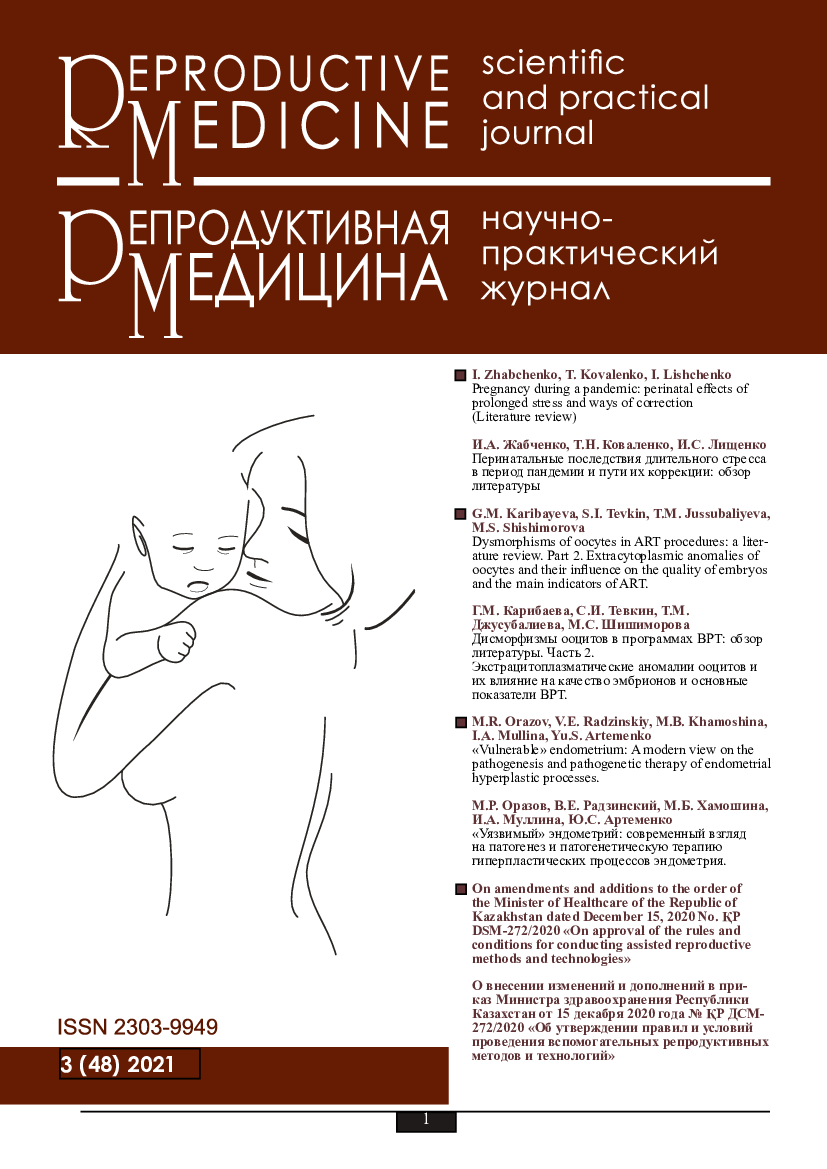Dysmorphisms of oocytes in art procedures: Literature review
Part 2. Extracytoplasmic oocyte abnormalities and their impact on the quality of embryos and the main indicators of art procedures
DOI:
https://doi.org/10.37800/RM.3.2021.44-53Keywords:
infertility, IVF, oocyte, morphological assessment of oocytes, assisted reproductive technology (ART)Abstract
Relevance: Assisted reproductive technologies (ART) are rapidly developing and in recent decades have become increasingly important due to the growing number of infertile couples around the world. Human oocytes are the main objects used in ART procedures. Consequently, the quality of oocytes can determine the key parameters of ART.
The purpose of this review was to analyze the literature and the results of studies in the field of ART devoted to extracytoplasmic dysmorphisms of human oocytes – morphological changes outside the cytoplasmic structure of oocytes, their effect on fertilization, cleavage, implantation frequency, clinical pregnancy rate, as well as the possibility of their use as biomarkers for predicting the quality of embryos, blastocysts, and their further implantation potential.
Materials and Methods: This literature review was based on a search conducted among domestic and foreign publications for 2000-2020 available in Russian and international search systems (PubMed, eLibrary) using the keywords "infertility,” “IVF,” "oocyte,” “morphological assessment of oocytes,” “dysmorphisms of oocytes ,” and “ assisted reproductive technologies.”
Results: This literature review contains literature data and the analysis of research results in the field of ART devoted to the morphological qualities and abnormalities (dysmorphisms) of human oocytes. It describes the types of extracytoplasmic abnormalities encountered in the clinical practice of in-vitro fertilization, their effect on fertilization, cleavage, implantation rate, and clinical pregnancy rate, as well as the possibility of their use as biomarkers to predict the quality of embryos and blastocysts and their further implantation potential.
References
Lasienë K., Vitkus A., Valanèiûtë A., Lasys V. Medicina, 2009; 45(7):509-515. https://doi.org/10.3390/medicina45070067;
Qassem E.G., Falah K.M., Aghaways I.H.A., Salih T.A. Acta med. Int., 2015; 2(1):7-13. https://doi.org/10.5530/ami.2015.1.3;
Rienzi L., Ubaldi F.M., Iacobelli M., Minasi M.G., Romano S., Greco E. Reprod. Biomed. Online, 2005; 10:192–198. https://doi.org/10.1016/s1472-6483(10)60940-6;
Rienzi L., Balaban B., Ebner T., Mandelbaum J. Human Reprod., 2012; 27(suppl_1):2–21. https://doi.org/10.1093/humrep/des200;
Swain J.E., Pool T.B. Hum. Reprod. Update, 2008; 14:431–446. https://doi.org/10.1093/humupd/dmn025;
Setti A.S., Figueira R.C.S., Braga D.P.A.F., Colturato S.S., Iaconelli A. Jr., Borges E. Jr. Eur. J. Obst. Gynecol. Reprod. Biol. 2011; 159:364–370. https://doi.org/10.1016/j.ejogrb.2011.07.031;
Alpha Scientists in Reproductive medicine and ESHRE Special Interest Group of Embryology. Hum. Reprod., 2011; 26:1270-1283. https://doi.org/10.1093/humrep/der037;
Zhao J., Zhang N-Y., Xu Z.-P., Chen L.-J., Zhao X., Zeng H.-M., Jiang Y.-Q., Sun H.-X. J. Reprod. Contraception, 2015; 26(2): 73-80. https://doi.org/10.7669/j.issn.1001-7844.2015.02.0073;
Balakier H., Sojecki A., Motamedi G., Bashar S., Mandel R., Librach C. Fertil. Steril., 2012; 98(1):77-83. https://doi.org/10.1016/j.fertnstert.2012.04.015;
Valeri C., Pappalardo S., De Felici M., Manna C. J. Assist. Reprod. Genet., 2011; 28:545-552. https://doi.org/10.1007/s10815-011-9555-3;
Sauerbrun-Cutler M.-T., Vega M., Breborowicz A., Gonzales E., Stein D., Lederman M, Keltz M. Journal of Ovarian Research, 2015; 8: 5. https://doi.org/10.1186/s13048-014-0111-5;
Rienzi L., Ubaldi F.M., Iacobelli M., Minasi M.G., Romano S., Ferrero S., Sapienza. Fertil. Steril, 90 (5), 2008: 1692–1700. https://doi.org/10.1016/j.fertnstert.2007.09.024;
Esfandiari N., Burjaq H., Gotlieb L., Casper R.F. Fertil Steril., 2006, 86 (5): 1522–1525. https://doi.org/10.1016/j.fertnstert.2006.03.056;
Balaban B., Urman B. Reprod Biomed Online, 2006; 12(5): 608-615. https://doi.org/10.1016/s1472-6483(10)61187-x;
Shi W., Xu B., Wu L.-M., JIn R.-T., Luan H.-B., Luo L.-H., Zhu Q., Johansson L., Liu Y.-S., Tong X.-T. PLOS one, 2014; 9(2): e89409. https://doi.org/10.1371/journal.pone.0089409;
Notolla S.A., Makabe S., Stallone T., Familiari G., Correr S., Macchiarelli G. Histology and Cytology, 2005, 68(2); 133-141. https://doi.org/10.1679/aohc.68.133;
Xu H., Deng K., Luo Q., Chen J., Zhang X., Wang X., Diao H., Zhang C. Cell Physiol. Biochem., 2016; 39: 677-684. https://doi.org/10.1159/000445658;
Li M., Ma S.-Y., Yang H.-J., Wu K.-L., Zhong W.-X., Yu G.-L., Chen Z.-J. Assisted Reprod. Genet., 2014; 31(3): 285–294. https://doi.org/10.1007/s10815-013-0169-9;
Sousa M., Silva J., Cunha M., Viana P., Oliveira E., Sa R., Soares C., Oliveira C., Barros A. Zygote, 2015; 23(1): 145-157. https://doi.org/10.1017/S0967199413000403;
Miao Y.-L., Kikuchi K., Sun Q.-Y., Schatten H. Human Reprod. Update, 2009; 15(5): 573-585. https://doi.org/10.1093/humupd/dmp014;
Yu E.J., Ahn H., Lee J.M., Lee B.C., Kim S.H. Clin. Exp. Reprod. Med., 2015; 42(4): 156-162 https://doi.org/10.5653/cerm.2015.42.4.156;
Hassa H., Aydin Y., Taplamacioglu F. J. Turk. Ger. Gynecol. Assoc., 2014; 15(3): 161–163. https://doi.org/10.5152/jtgga.2014.13091;
Farhi J., Nahum H., Weissman A., Zahalka N., Glezerman M., Levran D. J. Assist. Reprod. Genet., 2002; 19(12): 545-549. https://doi.org/10.1023/a:1021243530358;
Zanetti B.F., Braga D., Setti A.S., Figueira R., Iaconelli Jr. A., Borges Jr. E. EJOG, 2018; 231: 225-229. https://doi.org/10.1016/j.ejogrb.2018.10.053;
Navarro P.A., de Araújo, M.M., de Araújo, C.M., Rocha, M., dos Reis, R., Martins, W. Int. J. Gynecol. Obstet., 2009; 104: 226-229. https://doi.org/10.1016/j.ijgo.2008.11.008;
Thrift K., Broman K., Garsia J., Wallach E., Zhao Y. Fertil. Steril., 2009; 92(3): 154-155. https://doi.org/10.1016/j.fertnstert.2009.07.1274;
Halvaei I., Khalili M.A., Soleimani M., Razi M.H. Int. J. Fertil. Steril., 2011; 5(2): 110–115. https://pubmed.ncbi.nlm.nih.gov/24963368/;
Ciotti P.M., Notarangelo L., Morselli-Labate A.M., Felletti V., Porcu E., Venturoli. Hum. Reprod., 2004; 19(10): 2334-2339. https://doi.org/10.1093/humrep/deh433;
Faramarzi, A., Khalili, M. A., Omidi, M. Hum. Fertil. (Camb.), 2019; 22(3): 171–176. https://doi.org/10.1080/14647273.2017.1406670;
Ebher T., Yaman C., Moser M., Sommergruber M., Feichtinger O., Tews G. Hum. Reprod., 2000; 15(2): 427-30. https://doi.org/10.1093/humrep/15.2.427;
Younis J.S., Radin O., Izhaki I., Ben-Ami M. J. Assist . Reprod. Genet., 2009; 26: 561–567. https://doi.org/10.1007/s10815-009-93-68-9;
Rose B. I., Laky D. J. Assist. Reprod. Genet., 2013; 30(5): 679-682. https://doi.org/10.1007/s10815-013-9982-4;
Zhou W., Fu L., Sha W., Chu D., Li Y. Zygote, 2016; 249(3): 401-407. https://doi.org/10.1017/S0967199415000325;
Fancsovits P., Tothne Z.G., Murber A., Takacs F.Z., Papp Z., Urbancsek J. ActaBiolHung, 2006; 57: 331-338. https://doi.org/10.1556/ABiol.57.2006.3.7;
Ebher T., Shebl O., Moser M., Sommergruber M., Tews G. Hum. Reprod., 2008; 23(1): 62–66. https://doi.org/10.1093/humrep/dem280;
Xiong S., Han W., Liu W., Wu L., Liu J. X., Gao Y., Huang G. Hum Fertil (Camb.), 2018; 21(3): 204-211. https://doi.org/10.1080/14647273.2017.1324181;
Halim B., Lubis H.P., Novia D., Thaharuddin M. JBRA Assist Reprod., 2017; 21(1):15–18. https://doi.org/10.5935/1518-0557.20170005;
Esfandiari N., Ryan E.A.J., Gotlieb L., Casper R.F. Reprod. Biomed. Online, 2005;11(5):620-623. https://doi.org/10.1016/s1472-6483(10)61171-6;
Romao G.S., Araujo M.C., de Melo A.S., de Albuquerque Salles Navarro P.A., Ferriani R.A., dos Reis R.M. Fertil. Steril., 2010; 93(2): 621-625. https://doi.org/10.1016/j.fertnstert.2008.12.124;
Lehner A., Kaszas Z., Murber A., Rigo Jr. J., Urbancsek J., Fancsovits P. Arch. Gynecol. Obstet., 2015; 292(3): 697–703. https://doi.org/10.1007/s00404-015-3679-0;
Rosenbusch B., Schneider M., Glaser B., Brucker C. Human Reproduction, 2002; 17(9), 2388–2393. https://doi.org/10.1093/humrep/17.9.2388;
Machtinger R., Politch J.A., Hornstein M.D., Gensburg E.S., Racowsky C. Fertil. Steril., 2011; 95(2): 573-576. https://doi.org/10.1016/j.fertnstert.2010.06.037;
Baykal B., Korkmaz C., Bahçe M., et al. SOJ Gynecol Obstet Womens Health, 2017; 3(2): 1-3. https://pdfs.semanticscholar.org/23cd/d0d2fd9c07152ea6eef2ed847c23244a504d.pdf;
Balakier H., Bouman D., Sojecki A., Librach C., Squire J.A. Hum. Reprod., 2002; 17(9): 2394-2401. https://doi.org/10.1093/humrep/17.9.2394;
Kawano H., Yamashita N., Ito J., Kashiwazaki N. Reprod. Med. Biol., 2021; 20(3): 260-266. https://doi.org/10.1002/rmb2.12378;
Rosenbusch B., Hancke K. RJME, 2012, 53(1): 189–192. https://doi.org/rjme.ro/RJME/resources/files/530112189192.pdf;
Cummins L., Koch J., Kilani S. RBMO, 2016; 32(1): 62–65. https://doi.org/10.1016/j.rbmo.2015.09.012;
Yano K., Hashida N., Kubo T., Ohasji I., Koizumi A., Kageura R., Furutani K., Yano C. J. Assist. Reprod. Genet. 2017; 34(11): 1547-1552. https://doi.org/10.1007/s10815-017-1012-5;
Turkalj B., Kotanidis L., Nikolettos N. Hippokratia, 2013; 17(2): 169–170. https://doi.org/ncbi.nlm.nih.gov/pmc/articles/PMC3743624.
Additional Files
Published
How to Cite
Issue
Section
License
The articles published in this Journal are licensed under the CC BY-NC-ND 4.0 (Creative Commons Attribution – Non-Commercial – No Derivatives 4.0 International) license, which provides for their non-commercial use only. Under this license, users have the right to copy and distribute the material in copyright but are not permitted to modify or use it for commercial purposes. Full details on the licensing are available at https://creativecommons.org/licenses/by-nc-nd/4.0/.




